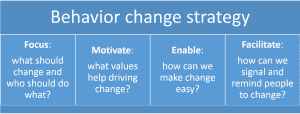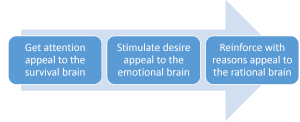Communication for behaviour change
Change is knocking © Frits Ahlefeldt, the Hiking Artist http://hikingartist.com/
Article from EUROPARC Journal – Protected Areas In-Sight 2015
Communication is at the heart of Protected Area! The guardians of our natural heritage work hard to inspire their local community and visitors the importance of nature conservation. But is it possible to shape behaviour through communications?
We asked Frits Hesselink, former Chair of the IUCN Commission on Education and Communication and Co-Founder of Frogleaps, to share with us his experience on Communication for Behaviour change.

Frits Hesselink
When I first started to work in the field of communication for protected areas and conservation, I thought that people behaved badly towards nature because of a lack of information. I was convinced that information, based on scientific fact, would change their attitudes positively towards nature. Therefore, the communication I carried out provided information on ‘why’ there are conservation problems. Yet, listening to people and evaluating this type of communication I realized:
- Negative messages about threats and extinction do not work. They have the opposite effect: People switch off and think “that’s a shame, but let’s move on”.
- Information does not lead to behaviour change. For such change , more is needed, like examples of what we can do to solve some of the problem.We should not try to convince people with rational arguments.
- Our emotional brain drives our behaviour. Persuasion is therefore a more effective way of convincing people to change. Information is needed only after we have stimulated their desire to change.

Behaviour Change strategy © Frits Hesselink
LEARNING FROM OTHERS
A protected area was struggling with visitor behaviour and the threats posed to biodiversity. Every year, the situation got worse with stakeholders blaming each other for the problem.
To create a change strategy we focused on one species and answered the questions “when is it threatened and by whom?” The species was the Greater Pasque flower. The ‘when’ was the protected area’s May 1st celebrations, and the ‘who’, the people who attended the celebrations. During the celebrations people camped, parked and rode motorbikes everywhere causing chaos disregarding the Pasque flower.
Using focus groups, people told us they loved the area and wanted to make May 1st May a festival for people and nature. They agreed to manage the event that made new behaviour easy, by introducing roadblocks, free busses and designated locations for camping and fires. The protected area managers signalled the need for change and informed stakeholders how they could contribute. A feeling of pride amongst the stakeholders was generated that the area was home to such a rare plant.
Ten years later I learned that the whole municipality was now involved in managing the successful event: The hunters had moved their corn field for wild boar away from the flower; the mountaineers had made a nature trail and a car park in the village; and the villagers were now actively promoting the area’s biodiversity. What was the recipe for this success? We helped them to do what they already wanted to do, triggered the right sequence of baby steps and a momentum of success. We made it a fun experience making it easy for them to change their behaviour.

Process © Frits Hesselink
Similar case studies are available on the Frogleaps website (www.frogleaps.org). More communication news is on the IUCN Commission on Education and Communication’s news blog: www.cectalksnature.org.
Are you interested in developing your communication skills?
Check our brand new Toolkit “Be a Better Communicator”, with dozens of articles and useful tips to get you started right away!